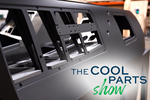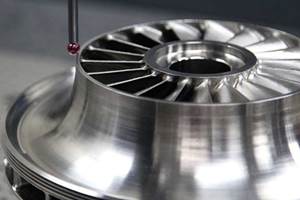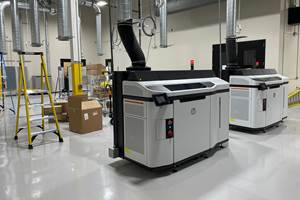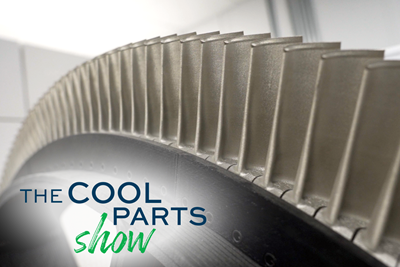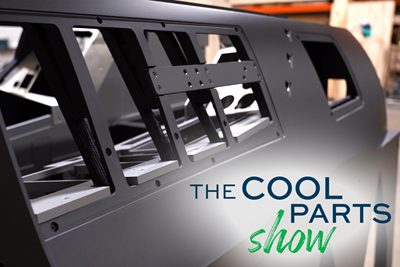Share
Read Next
Magnets are key to many everyday objects, from the mundane (a refrigerator seal) to the complex (smartphones). They also play a critical role in motors and generators, applications of particular concern to the Department of Energy. The United States has no domestic source for neodymium iron boron, a rare earth element commonly used in these magnets, and so the DOE’s Critical Materials Institute has invested in researching new methods of using and conserving these materials. In this episode of The Cool Parts Show, we look at one of several 3D printing methods that has been used successfully to create magnets. | This episode of The Cool Parts Show brought to you by Carpenter Additive
The Cool Parts Show is a video series from Additive Manufacturing Media that explores the what, how and why of unusual 3D printed parts. Watch more here.
Have a cool part to share? Email us.
Related Resources
- Oak Ridge National Laboratory Manufacturing Demonstration Facility
- Another episode involving 3D printing work done at the MDF
- Other examples of cool parts made with Big Area Additive Manufacturing (BAAM)
Transcript
Stephanie Hendrixson
3D printing and magnets, a great combination or polar opposites? Find out in this episode of The Cool Parts Show.
Stephanie Hendrixson
This episode of The Cool Parts Show is brought to you by Carpenter Additive. The company's Powder Life solution is a combination of hardware and software technologies designed to help AM users manage their metal powders. Stay tuned after the episode for more on how the system works.
Pete Zelinski
I'm Pete.
Stephanie Hendrixson
I'm Stephanie.
Pete Zelinski
Welcome to The Cool Parts Show.
Stephanie Hendrixson
This is our show all about cool, unique, interesting, amazing 3D printed parts. And what better place to find them than the Manufacturing Demonstration Facility here at Oak Ridge National Labs.
Pete Zelinski
We are working with Oak Ridge on a variety of episodes of the show on various additive manufacturing successes. And this one, Stephanie, I feel like is really attractive.
Stephanie Hendrixson
You could say that quite literally because today's part is a 3D printed magnet.
What are some of the issues with magnets?
Pete Zelinski
Okay, so before we got into this, I didn't even know you could 3D print magnets, we have learned a lot. Stephanie, what are some of the issues with magnets?
Stephanie Hendrixson
Good question. So conventionally, magnets are made in a couple of ways. One is through molding where you are molding the magnetic material and then sintering it to its final density. That puts a lot of restrictions on the geometries that you can achieve. And if you need to change the size or shape of the magnet, you need new tooling. The other way might be to start with a big block of magnetic material and to slice and dice it down into the sizes and shapes that you want. That can lead to a lot of waste, you might be losing as much as 50% of the material off of that original block.
Pete Zelinski
And that's a big deal, isn't it, reducing waste is a big deal because this is a difficult to obtain material.
Stephanie Hendrixson
That's right magnets are made from rare earth elements. Specifically what we're talking about today is neodymium iron boron, which most of that is mined in China today. There's actually no domestic source here in the US. So this is a materials issue, but it's also a supply chain issue. Part of that is because magnets are in so many of the things that we use every day. They're in motors and generators and things like that. That's why Oak Ridge as part of the Department of Energy is so interested in this problem and they're studying it through their Critical Materials Institute. Let me introduce Parans Paranthaman, one of the corporate fellows working on this project to describe why this research is so important.
Parans Paranthaman
So magnets are used like sensors, motors, generators, or the magnets are used in speakers, or if you want to store data in a computer, or magnetic resonance imaging. And also if you take your car, the one we drive every day, it has like 37 kinds of magnetic parts there. Typically these are rare earth metals or rare earth oxides, what we call lanthanides. So this Critical Materials Institute, it was created like eight years ago. And it's a US Department of Energy's innovation hub, hosted by Ames Laboratory, and Oak Ridge National Lab, Idaho National Lab, Lawrence Livermore are part of it. The key thing is we want to focus on materials that can be used very efficiently in any of these magnet applications or clean energy. And we want to help American competitiveness for clean energy and the challenge is we want to have a domestic supply chain for any of these. Either you want to use some material efficiently, or you want to replace the critical materials or you want to recycle.
How do you 3D print a magnet?
Pete Zelinski
Okay, so reducing waste, we've done other episodes of the show that sort of explored that the way that 3D printing lets you control, minimize, even optimize how much how little material you use. And that's really important here, that's a very big deal here because of the material involved. Let's go to the beginning. How do you do that? How do you 3D print a magnet?
Stephanie Hendrixson
So they've tried a couple of different methods. You can do it through laser powder bed fusion, you can do it through binder jetting, which is sort of similar to that mold and sinter process but the technology that's maybe furthest along is the one that's right behind us, the BAAM, the big area additive manufacturing machine.
Pete Zelinski
Okay, so yeah, BAAM, big area additive manufacturing, a platform from Cincinnati Incorporated, an extrusion 3D printing process building parts layer by layer by extruding material. Significantly, it doesn't use coils of material that are custom made for 3D printing but instead uses pellet material like you might use in injection molding. Which sort of gets to my question, BAAM is for polymer and magnets are metal, right?
Stephanie Hendrixson
So that's a good question. So what they're printing here is actually a polymer-bonded magnet. So that magnetic material is mixed in with thermoplastic. That's what the printer is extruding and so it prints like a plastic but it functions like a magnet.
Pete Zelinski
This seems like a dumb question. But it's magnetic, right? How do you print with it like doesn't stick to the metal in the 3D printer?
Stephanie Hendrixson
Not a dumb question, something that I did not understand at the beginning of this. So actually, as you are building up the geometry, the magnetic material is not magnetized, you build the whole form first, and then you magnetize it all at once. I'll let Parans explain how that works.
Parans Paranthaman
A lot of times magnets have a curing Temperature. So if you take the neodymium iron boron, the curing Temperature is slightly above 300 degrees Celsius. So once you take this magnet, anneal slightly about 300 degrees Celsius, it becomes not magnetic. Once you take the printed magnets and expose them to a magnetic field, immediately magnetizes.
What are the challenges to 3D printing magnets?
Pete Zelinski
They're experimenting with creating magnets through 3D printing, they're using the polymer as a carrier for the magnetic material. I guess I've got a lot of questions about that. Like, is it really that easy? Are there challenges to 3D printing magnets? Is there further that they need to take this idea?
Stephanie Hendrixson
Yeah, so challenges, we talked about how the material is this composite, it's a combination of the magnetic metal and the thermal plastic. And that in itself is a challenge, you want to maximize the amount of magnetic material in the magnet because that's what provides the strength. But at the same time, you can't go too far, or else you'll lose the properties of the plastic that make it printable. So that is a challenge.
Parans Paranthaman
BAAM or FDM process the challenges are, first, the magnetic properties, how close to the full density magnet. There are methods where you can use sacrificial binder, you can mix it with that, and do post-processing, where you can do the sintering, and there will be a small contraction in size, but one can get full density. But the challenge is can we do it with this magnet composition to achieve full density because the loading and the performance grow exponentially. And the magnetic performance, especially like energy products, it's directly proportional to the square of the volume of magnetic material present in a composite. So let's say 70 volume percent, point seven squared, you get only 50% of your starting magnet out of it. So if you want to achieve full density, you want to increase the loading. That's one challenge. And the other challenge is we want to have mechanical properties. You are mixing the polymer and everything, so we have to maintain the mechanical properties. So that's another challenge. And surface finish, like defects, porosity, we talked about various challenges we have associated with printing, that's one thing. And another key parameter is there are anisotropic and isotropic magnets. Anisotropic magnets, where you would align the magnets everything into the perpendicular direction, in one direction, so that the magnets can be very strong. Even if you take a small printed magnet, it can be strong enough to use in small cellphone speakers. So we want to align the magnets while printing. So we are doing research right now. And like fixing this pulsed magnetic field, or field around the nozzle, and print and align all at the same time. So, these are the challenges we are looking into.
Pete Zelinski
So there's this theme that keeps coming up on The Cool Parts Show. And it comes up so frequently it feels like a habit to us now. And it's you choose 3D printing, you choose additive manufacturing because it solves a problem, it solves the problem you were looking to solve. But then because you've embraced additive, it opens the window to this other opportunity you weren't looking for because of the freedoms that additive brings. And I wonder if anything like that is happening with 3D printed magnets.
Stephanie Hendrixson
Yeah, so that is happening here. I mentioned the blend of material as a challenge earlier, but that could also be an opportunity. So far, most of the printing they've been doing has been with a fixed ratio of that blend of material. But that doesn't have to be the case. With 3D printing, you could actually vary the amount of magnetic material in different parts of the actual part. So that could be a way of conserving that resource, using less of the rare earth elements because you're only putting them exactly where you need to.
Parans Paranthaman
So graded magnets are typically used in, right now offshore direct drive wind generators. Things like magnetic field, it doesn't have to be everywhere. So based on the modeling, we can see where exactly the strong magnets are needed. That cannot be done by simple sinter manufacturing. Whereas here, we think about multi-material processing, that's the future. So instead of just mixing one pellet and do the printing using FDM or a BAAM printer, one can use more than two sources. So you can mix and it'll go through a single nozzle, so you can form a gradient. This way, for things where we need a strong magnetic field we can use dysprosium-containing, critical material containing magnets so that we generate a high magnetic field, and in the areas where you don't need it, you can really see dysprosium composition. So, this is the freedom that we have, this cannot be done by regular manufacturing.
Pete Zelinski
Alright, I think I got this. 3D printed magnet, magnetic materials are rare, difficult to obtain, we get the materials from other parts of the world, very valuable to conserve material to use as little material as possible. 3D printing is a means to do that. And the means of 3D printing that looks very promising for 3D printed magnets is the extrusion process, extrusion specifically on the BAAM platform, big area additive manufacturing. But the bigness isn't the issue here because both small magnets and large ones are made on this platform. Instead, it's valuable for the pellet-fed extrusion process that allows a polymer material to carry this magnetic material. The part is not magnetic when it's 3D printed, then the magnetism is activated later. And a possibility that the Oakridge researchers are exploring is a gradient magnet. So don't just use the amount of material you want to use, but obtain exactly the magnetic field you want to obtain by varying the magnetism across different regions of the components.
Pete Zelinski
I think that's it for this episode. Thank you again to Oak Ridge and the Manufacturing Demonstration Facility. You can find more episodes that we're filming here at the MDF at TheCoolPartsShow.com or our YouTube channel.
Pete Zelinski
Keep watching, future episodes will be less polarizing. And if you've got a cool part to share, email us CoolParts@AdditiveManufacturing.media.
Stephanie Hendrixson
Thanks again to our sponsor Carpenter Additive. In addition to supplying metal powders, the company also offers services, software, and hardware to help AM users manage their powder. One example is the PowderLife system a combination of cloud-based tracking software with hardware designed to make powder handling easier. Two key components are the PowderLife Hopper and the Automated Docking Station. Luke Boyer, manager of PowderLife applications, and Andrew Holliday, Applications Engineer explained how the system works.
Luke Boyer
So today, when a user of additive manufacturing is receiving powder, they oftentimes receive it in either five, 10, 15, maybe a 20-kilo bottle, but they're receiving pallets of them and you're receiving 10, 20, 50, or hundreds of these bottles. The user has to look and segregate and store them appropriately so the bottles don't get mixed up and it requires a lot of lifting and moving and labor.
Andrew Holliday
The components of PowderLife are all based around making powder management systems on the additive manufacturing shop floor easier to use for the operator, cleaner, as well as more traceable. Three of those basic parts of PowderLife are our PowderLife hoppers or our storage containers for powder. The second would be an automated docking system that allows the material to be pushed in and out of machines with no human contact. The third would be our PowderLife online software system that allows you to trace this powder as it goes through your shop floor.
Luke Boyer
The hardware and the software together just help to streamline that and improve the final user's experience and let them concentrate on going from design to the part itself. It takes the headache of powder management out of the equation for them.
Related Content
Velo3D Founder on the 3 Biggest Challenges of 3D Printing Metal Parts
Velo3D CEO and founder Benny Buller offers this perspective on cost, qualification and ease of development as they apply to the progress of AM adoption in the future.
Read MoreThis Year I Have Seen a Lot of AM for the Military — What Is Going On?
Audience members have similar questions. What is the Department of Defense’s interest in making hardware via 3D printing over conventional methods? Here are three manufacturing concerns that are particular to the military.
Read MoreWhat Does Additive Manufacturing Readiness Look Like?
The promise of distributed manufacturing is alluring, but to get there AM first needs to master scale production. GKN Additive’s Michigan facility illustrates what the journey might look like.
Read MoreVideo: 5" Diameter Navy Artillery Rounds Made Through Robot Directed Energy Deposition (DED) Instead of Forging
Big Metal Additive conceives additive manufacturing production factory making hundreds of Navy projectile housings per day.
Read MoreRead Next
3D Printed Turbine Blades for More Efficient Power Generation: The Cool Parts Show #35
Blades made through additive manufacturing promise to let turbines run hotter, and therefore generate more power without increasing in size.
Read MoreFlight Simulator Made Through Large-Scale 3D Printing: The Cool Parts Show #33
Our biggest cool part so far! Printing this massive structure in one piece saves cost and time for L3Harris.
Read MoreBike Manufacturer Uses Additive Manufacturing to Create Lighter, More Complex, Customized Parts
Titanium bike frame manufacturer Hanglun Technology mixes precision casting with 3D printing to create bikes that offer increased speed and reduced turbulence during long-distance rides, offering a smoother, faster and more efficient cycling experience.
Read More

.jpg;width=70;height=70;mode=crop)

